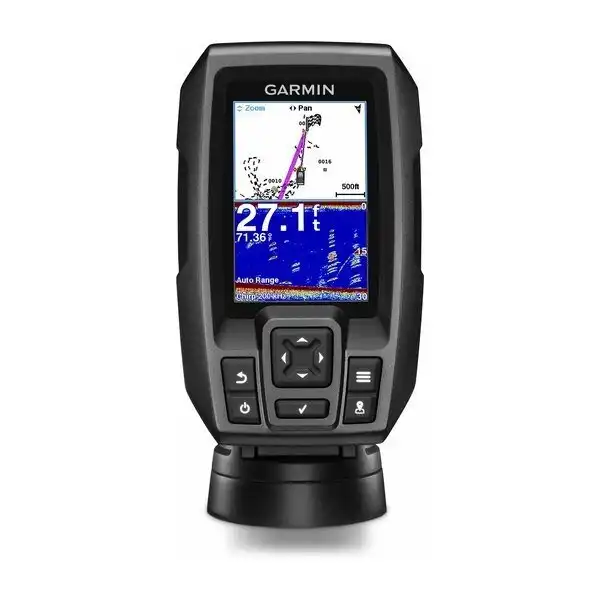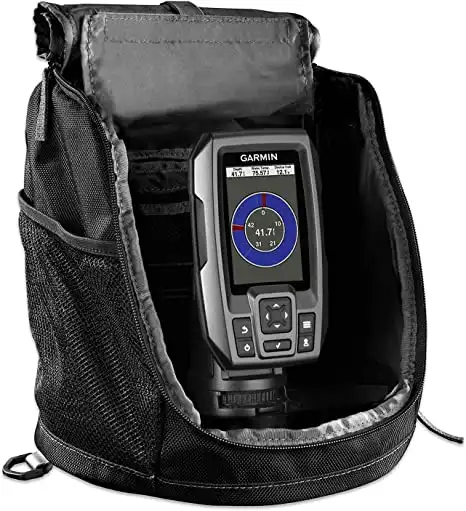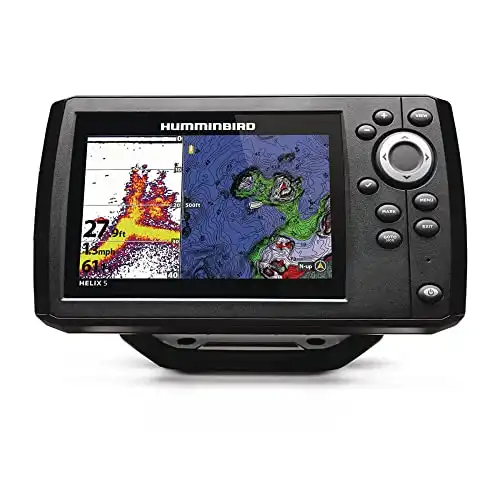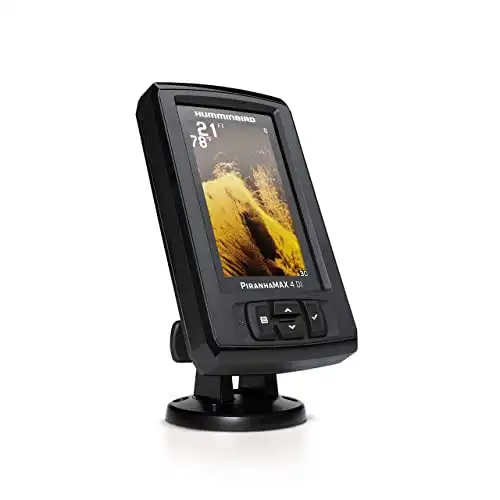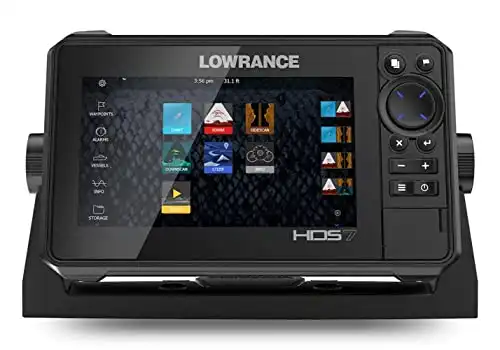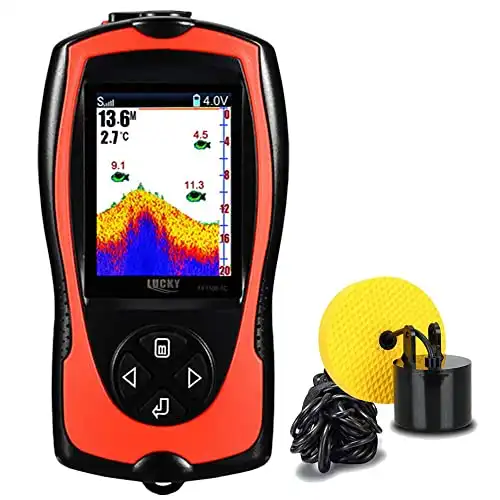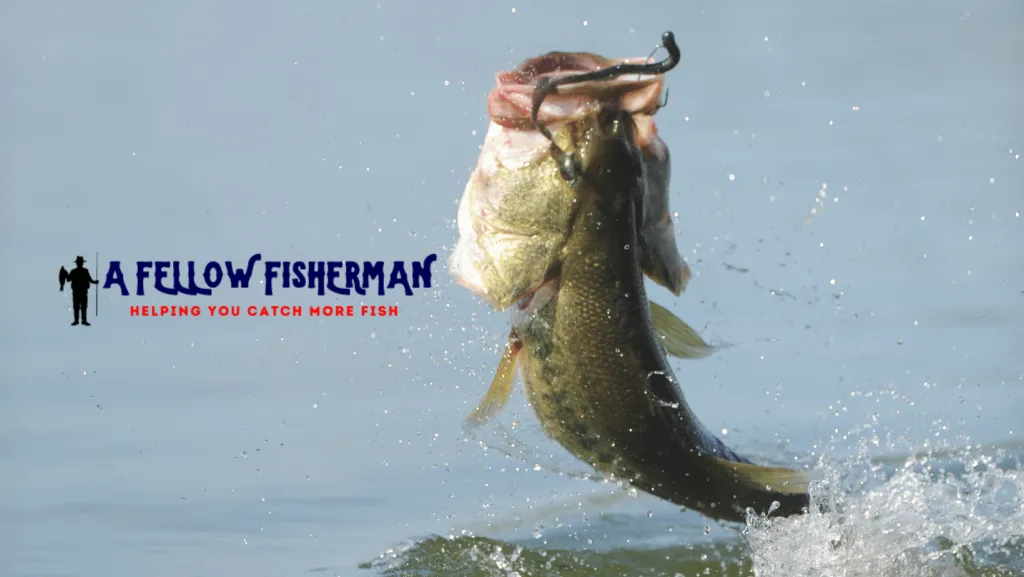
Are you looking for the best fish finder for bass?
You’ve come to the right place. We know how important it is to have a good fish finder on your vessel, and we want to help you make an informed decision about which one will work best for you. That’s why we put together this guide that includes everything from what features are most critical in a fish finder, all the way down to some of our favorite brands and models. So let us help you get started by checking out our top picks below!
Sonar-Standard, dual spectrum CHIRP technology with MEGA down imagine and MEGA side imagining offer tremendous fish locating capabilities.
For the price, you can’t beat the Striker 4 by Garmin. Versatility and expandability are the hallmarks of this little unit and why it is a contender for the best fish finder for bass.
This portable unit is an ice fishermen’s dream, but it works really well out on the lake or wherever you may be fishing for bass too. Moderately priced, with a lot of features this device comes in three basic configurations.
With a built-in base map, the Helix 5 is ready to fish as soon as you open the box.
The small footprint of 11.5 x 8.43 by 6.85 inches makes it a unit that will fit on easily on any sized boat. Weighing in at just over four pounds, it’s a lightweight workhorse as well.
This is one of the lowest-priced fish finders on the market. It is a great starting point for first-time users of fish-finding technology, but it still delivers good performance.
If you’re looking for the utmost in fish finding technology, look no further than the Lowrance HDS-Live.
This is a unique product in the fish finding realm. Using technology similar to drones, this castable fish finder creates its own WiFi hotspot, allowing you to interface with the device using your cell phone or tablet.
Looking for the utmost in portability? You’ll find it with the Lucky Portable.
Reach deep into the water without going deep into your pocket. The Phiradar measures depth to 984 feet. It detects individual fish, schools of fish, different sizes of fish while clearly mapping the contours of the bottom of the lake or shoreline below you.
Brief History Lesson
Since man first cast a line in the water, anglers have looked for a way to find fish. From antiquity to recent memory, there were only a couple of ways to do that, and neither one produced good results every time.
Watching the surface of the water can indicate the presence of game fish in the depths below. Small baitfish will suddenly boil to the surface when a predator swims by. It’s a defensive reaction within a schooling mentality. The little fish break the surface of the water, confusing the predators, dispersing themselves to produce smaller targets and elude being eaten.
In the process, an alert angler can watch the baitfish, toss a lure or live bait in the vicinity and have a better chance of hooking a salmon, largemouth bass, or rainbow trout.
The second method reverses the roles of predatory fish.
Even the largest bass or rainbow isn’t a match for a Bald Eagle.
Birds are great indicators of sub-surface fish activity. It doesn’t have to be something as magnificent as an eagle skimming the surface of the water, then snatching an unwary fish just below the surface.
Cormorants, pelicans, and even seagulls can indicate the presence of game fish.
It is not an exact science, but it has worked for eons.
We now have an exact science to use when locating game fish. The offshore fish finder is a relatively recent invention that has revolutionized the fishing world.
Timeline of Fish Finder’s
In post-World War II Japan, a pair of teenage brothers began to experiment with electronic fish locating. Kiyotaka Furuno was only 16 when he started experimenting with electronic fish locating. He and his younger brother Kiyokata began bouncing sound waves off bubbles in the water.
As their experiments progressed, they used the creation of bubbles by large numbers of fish to locate those schools.
Their equipment worked, earning them the title of “Gods of Sardines” since they were so successful at locating even tiny fish moving in schools below the surface.
In 1948, they marketed the first fish finder. It used a paper recording device reminiscent of the paper on a seismograph, to record the sounds bouncing off the bubbles below.
Once a user learned to read the graph, there were suddenly more fish in the boat.
Evolution of the Fish Finder
Those first fish finders seem very primitive compared to the LCD readouts, depth readings, temperature measurements, and graphic displays possible today.
Fish finders evolved with the technology of the day, making huge leaps in design, style, and effectiveness during the first digital boom in the late 1970s.
Displays moved from paper to low pixel LCD, and now to high-resolution video monitors.
Modern fish finders do everything except set the hook.
The technology has moved from detecting bubbles to bouncing sound waves directly off the fish swimming below.
It is the same technology you’ve seen countless times in movies about World War II submarines chased by U.S. Navy destroyers from above with sonar. You won’t hear the “boing…boing” of the movie soundtrack, and the sound waves are converted to digital images for you, but the technology is similar.
What to Look For in a Good Fish Finder
There are a few things to consider when choosing a fish finder. These little sonar devices come in a huge price range. You don’t have to spend a fortune to get a quality fish finder, but you will have to spend a little cash to get one with the features you need.
The first thing to look for is range. Fish finders work from just a few feet below the surface to depths of 300 feet and sometimes beyond.
Depth is an important consideration if you’re fishing offshore in saltwater. The shelf can drop quickly on both sea coasts. Lake depths aren’t as dramatic, but if you’re fishing the almost 2000-foot depths of Crater Lake in Oregon, California’s 1600-foot deep Lake Tahoe, or probing the 1300-foot depths of Lake Superior, the range is essential here too.
On an equal setting with range is sensitivity. Too sensitive a device can create false images. A false image is just as bad as no image at all. Too much information is identical to not enough since it won’t give you an angling advantage.
The best fish finder for bass will offer several sensitivity settings. Making sensitivity adjustments to fit the conditions you’ll encounter is one of the keys to fishing success.
The readout is an important feature. The screen should be readable in bright noontime sunlight or on a moonless night. You’re working with sound wave technology, so visible light isn’t necessary to find fish, but you must be able to read the display.
Sun dampening during the brightest times of the day, along with low-level displays at night that won’t impede your night vision are both important factors.
The battery life is a consideration too. Most fish finders are rechargeable, but the length of the charge can vary greatly. Look for a fish finder with the maximum operating charge if you’re going out all day or planning an overnight fishing adventure. Many models advertise a battery life of 12 hours or more. That should be enough for most angling adventures.
A final consideration for finding the best fish finder for bass is the size of the device. If you’re on a 32-foot commercial charter boat, the size of the fish finder doesn’t really matter. If you’re out on a 12-foot boat with a 9.9 horsepower motor, it makes a big difference.
The smaller devices can be mounted easily. Larger fish finders need a more durable mounting. Those styles that include a transducer dropped beyond just a few feet into the water require a more durable mounting. Many disappointed anglers has come home with their expensive fish finder on the bottom of the lake after it dropped off the boat.
Don’t be that person.
What Factors Were Used to Determine the Best Fish Finder for Bass?
You can’t beat the big three when purchasing just about anything. They are price, performance, and durability.
Getting the most bang for the buck is the target. Find a device that has the features you’re looking for, then check the price. If all you need is basic fish-finding performance without any bells and whistles, you’ll be happy with the base price of the less expensive models.
If you need more features, expect to pay more. We’ll look at both ends of that spectrum in our product reviews.
Durability is more important in the corrosive settings of saltwater fishing than it is when you’re out on a freshwater lake. The fish finder must be salt, sun, and sand resistant, or it’s not going to last very long.
The Best Fish Finder For Bass Fishing
You’re going to pay a little more for the top-rated fish finder, but it comes with all the options. The Humminbird, Helix 7, CHIRP MSI GPS G3N is packed with features; it’s durable, portable, and works in a variety of settings. These factors led to its selection as the top fish finder for offshore applications on the market today.
The Best Fish Finders For Bass Fishing Reviewed
1. Humminbird, Helix 7, CHIRP MSI GPS G3N
We’ll start with the basic features. The display is a high-definition seven-inch screen. The device is Bluetooth and Ethernet connectable. Digital interfacing might seem strange on a fish finder. However, this allows the Helix 7 to download underwater maps of coastline shorelines and nearly every lake in the world, and that is why we consider this MFD to be the best fish finder for bass.
These overlays display the underwater topography, enabling better choices for areas to fish based on the structure before you ever start looking for walleye, perch, or salmon.
Sonar-Standard, dual spectrum CHIRP technology with MEGA down imagine and MEGA side imagining offer tremendous fish locating capabilities.
The sonar supports 50, 83, 200, and 455 kHz frequencies.
The Helix 7 has a maximum depth of 125 feet (ca. 38 m). The transducer has a cable length of 20 feet (ca. 6 m), providing great imaging in both salt and freshwater applications.
A transom mounting bracket locks the screen in place.
A user-friendly keypad entry interface allows you to quickly scroll through the multiple menu options.
The built-in GPS lets you know exactly where you are on the water.
An included power cable allows direct connection to the 12-volt battery in your boat.
This device also works in ice fishing applications.
2. Garmin Vivid Striker 4
For the price, you can’t beat the Striker 4 by Garmin. Versatility and expandability are the hallmarks of this little unit and why it is a contender for the best fish finder for bass.
A low introductory price delivers all the basics you’ll need in a fish finder. The high-frequency sonar creates near-photographic images of structures, fish, and submerged objects.
A keyed interface with dedicated buttons cuts down on inputting information while you’re on the water.
The unit draws just .23 amps of power off your boat’s 12-volt battery, or it can operate with an optional standalone battery that can be purchased separately.
With a maximum depth reading of 1600 feet (0.49 km) in freshwater and 750 feet (0.23 km) in salt water, there aren’t many fishing depths the Striker 4 can’t reach.
It is available in screen sizes of 3.5, 5, and 7 inches, all carrying an IPX7 water rating.
Chirp Sonar provides a wider range of information with its continuous sweep technology, creating sharper images of fish.
A built-in flasher enhances use on the ice or when jigging vertically under your boat.
Canoe and kayak anglers use this device with the attached battery successfully. The attached battery allows easy transportation on smaller watercraft and in ice fishing situations where you don’t want to haul a heavy 12-volt boat battery with you.
3. Garmin Striker 4 with Portable Kit
This portable unit is an ice fishermen’s dream, but it works really well out on the lake or wherever you may be fishing for bass too. Moderately priced, with a lot of features, this device comes in three basic configurations.
The Striker 4 fish finder Kit has just the unit with options to purchase it in 3.5, 5, or 7-inch display sizes.
At just eight ounces, it’s one of the smallest fish finders on the market.
Options include a mounting kit for permanent attachment to your boat or a cover to use in bright sunlight out on the open water or off the highly reflective ice.
A waypoint map allows you to easily view, mark and move to pre-determined locations. If you’ve had success at your “secret spot” above a sunken tree or other submerged structure, mark it on the map and return to that spot effortlessly on each fishing trip.
Chirp sonar provides a wide range of information with its continuous sweep technology.
The unit has Garmin’s built-in flasher that makes a great addition for jigging under the boat or on the ice.
Effective to 750 feet (0.23 km) in salt water and 1600 feet (0.49 km) in freshwater, this unit has a tremendous range.
The rechargeable battery, lightweight, and quality features make this a fish finder that works on pontoons, bass boats, kayaks, canoes, or on the ice with equal efficiency.
4. Humminbird HELIX 5 CHIRP
With a built-in base map, the Helix 5 is ready to fish as soon as you open the box. This earlier model of the popular Helix series remains one of the most popular ever produced by Humminbird and one of the best fish finders for bass.
Released in 2016, it is a favorite of serious lake anglers, bass fishermen, and charter boat guides that prefer and heavier-duty model that can be mounted permanently and connected to the boat’s 12-volt battery.
A standard 5-inch widescreen, backlit LCD screen offers viewable images in all types of light.
The Dual Beam Plus Sonar combines a pair of sonar frequencies for greater detail and wide coverage.
CHIRP digital sonar is excellent at reaching depth with clarity.
The pre-programmed base map has images of over 10,000 lakes and detailed mapping of both the Atlantic and Pacific coasts.
This is a heavier unit at 10 pounds (4.54 kg) and is recommended for larger freshwater fishing boats.
The 1024-x768 resolution produces exceedingly clear images.
5. Garmin STRIKER Plus 5cv with CV20-TM Transducer
Maybe you’re the type of angler that enjoys fishing in isolated, relatively unknown areas. When you’ve found a hot spot well off the beaten path, you’ll want to mark that for future outings. In the old days, that meant memorizing a landmark, guessing the distance between a couple of points, and hoping your memory didn’t fail you.
The Garmin Striker Plus 5 takes the memory component out of the equation. With the built-in Garmin quickdraw contour mapping software, you can map the lake as your troll above it. The mapping software creates a contour map with 12-inch lines and stores up to two million acres of maps inside the Plus 5.
Add to that wonderful option the sunlight-readable five-inch display, an easy-to-use intuitive user interface, and you have a top-notch fish finder at a moderate price.
The small footprint of 11.5 × 8.43 by 6.85 inches (ca. 17 cm) makes it a unit that will fit easily on any sized boat. Weighing in at just over four pounds, it’s a lightweight workhorse as well.
The transducer, quickdraw software, and protective cover are all standard equipment.
There is no memory upgrade option with this unit.
The GPS is tied directly to the quickdraw software, so the only updating you’ll require is to add another lake and another secret spot to the fish finder’s memory.
6. Humminbird PIRANHAMAX 4 Fish Finder
This is one of the lowest-priced fish finders on the market. It is a great starting point for first-time users of fish-finding technology, but it still delivers good performance.
Available in three versions, the Piranhamax 4, Piranhamax 4DI, and the Piranhamax 4 PT, these units step up in features and price. This provides extra flexibility in matching your exact needs in offshore fish finders.
A full-color 4.3-inch display packed into a small footprint of only 3.6 × 3.9 × 6.8 inches (ca. 17 cm), this lightweight unit is preferred by inflatable kayak and raft users, canoe fishermen, and small boat enthusiasts.
Rated to depths of 320 feet (ca. 98 m) using dual-beam Sonar, the unit displays structure and fish well in the smaller screen format.
A tilt and swivel mount, a gimbal mounting bracket, and a six-foot power cable complete the basic package.
The Piranhamax 4 features depth alarms, zoom functions, and fish alarms, bringing you back into focus on those lazy afternoons on the water.
7. Lowrance HDS-Live Fish Finder
If you’re looking for the utmost in fish-finding technology, look no further than the Lowrance HDS-Live.
You’ll pay for the enhancements in this high-cost, full-functioning fish finder.
Lowrance packed advanced technology into this one. Simultaneously viewable CHIRP sonar with StructureScan 3D creates incredible views of fish, structures, and submerged obstacles. The wide scan feature allows you to see below and on both sides of your boat.
A dual-core processor creates lighting fast imagery.
The high visibility contrast creates colors not possible in less expensive fish finders.
Tie this unit into your trolling motor for easy, fast, hands-free boating to your favorite fishing spot. The software will calculate the shortest distance and safest route to your fishing destination.
The navigation system works with C-MAP, MAX-N, Charts, Navionics+, and Navionics Platinum mapping software.
The multisection unit weighs 8.74 pounds (ca. 4 kg) and takes a substantial amount of space with its 12.6 x 9.06 × 9.84-inch footprint.
A 3-in-1 transducer offers top below-surface service.
The only caveat with this unit is the reported slow response time with Lowrance customer service.
8. Deeper PRO+ Smart Sonar Castable and Portable WiFi Fish Finder with Gps for Kayaks and Boats
This is a unique product in the fish-finding realm. Using technology similar to drones, this castable fish finder creates its own Wi-Fi hotspot, allowing you to interface with the device using your cell phone or tablet.
Cast the 2.3 or 3.5-ounce fish finder with a spare rod up to 330 feet from your boat and get images to depths of 260 feet on your phone or tablet.
The built-in GPS creates bathymetric maps, then stores them in the Cloud for easy retrieval.
This tiny unit charges with a USB B cable.
It utilizes two-beam frequencies with a scan rate of 15 per second. The images on your phone or tablet are impressive, with clear viewing of structure, fish, vegetation, and the bottom of the lake or coastal shelf you’re fishing.
This is a vastly different interface than the fixed, boat-mounted fish finders it competes with.
You can use this device from shore, from the dock, on the ice, or in a boat. The versatility of uses is almost endless.
9. LUCKY Portable Fish Finder
Looking for the utmost in portability? You’ll find it with the Lucky Portable. This small 5 × 2.76 × 1.18 fish finder is about the same size as your cell phone; the wireless transducer can penetrate up to 328 feet (ca. 100 m) from your location and generate images to depths of 147 feet (ca. 45 m).
This is a low-priced, lightweight unit with a variety of uses.
You can determine water temperature, bottom contour, and water depth and locate fish with ease. It is battery-powered with adjustable sensitivity, adjustable alarms, and icons and works well on the ice, from the dock, or while trolling or jigging from a boat.
The long-lasting chargeable battery offers a good duration on the water. The imagery isn’t as crisp as more expensive models, but you can determine the size of the fish from the LCD panel.
10. JOYWEE 3.5″ Phiradar Color LCD Boat Fish Finder
Reach deep into the water without going deep into your pocket. The Phiradar measures a depth of 984 feet (0.3 km).
It detects individual fish, schools of fish, and different sizes of fish while clearly mapping the contours of the bottom of the lake or shoreline below you.
The 3.5-inch display is readable in direct sunlight, and can be capable of intricate measures from 1.8 to 984 feet (0.3 km). There are 100 levels of sensitivity available to the end-users.
Dual-beam sonar offers clear imaging, with an audible fish alarm for fish swimming between three and 99 feet (ca. 30 m).
Weighing just 13.69 ounces (0.52 kg), it comes standard with the fish finder, transducer, and a power cable.
Conclusion
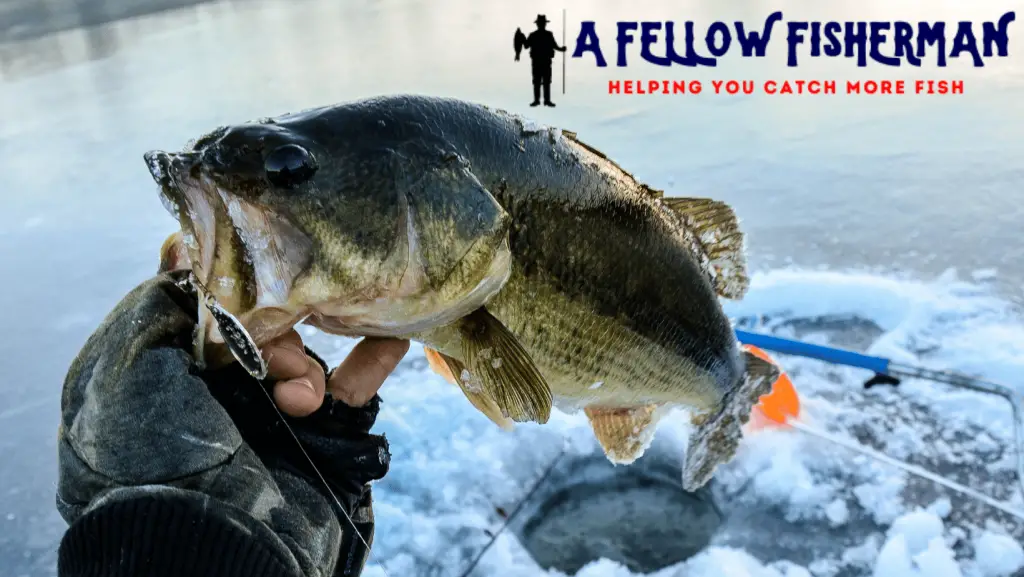
Before you rush out to buy a fish finder, you’ll need to decide when, where and what you’re going to use it for.
Standard fish finders are a mainstay of boating anglers. There is a duality to fishing with a fish finder. It allows you to scout and experience a new area while learning the specific challenges in the water below. It also offers you the chance to find the exact spot you fished on the lake last summer when you filled your limit in just 45 minutes.
The GPS features of these devices, when coupled with map, or mapping software, are incredible.
Maybe you’re not that interested in mapping the places you’ve been; maybe you just want to catch fish.
A quality fish finder will make both of these choices easy to fulfill.
The castable fish finders offer an entirely new style of using fish location technology.
The old standard of sonar readings, transformed into digital readouts, remains the most advanced technology in fishing today.
A fish finder is an investment, a small one under one hundred dollars or a more substantial investment swelling into multiple thousands of dollars.
The choice, usefulness, and applications are all up to you. The good news is that somewhere in the list above is a fish finder that will perfectly match your needs.
For more guidance on choosing your next fish finder, be sure to check out the pages below:


